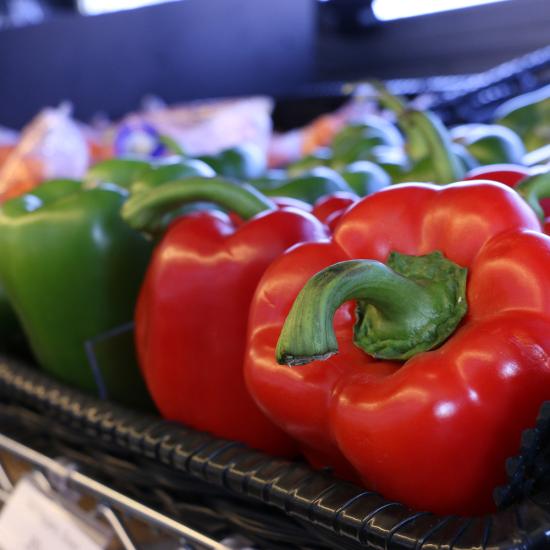Seven Online Resources for Food Access
What are food deserts? And what can we do about them?
Through Twin Cities Mobile Market, Wilder uses a retrofitted bus to bring fresh, affordable foods to under resourced neighborhoods in Saint Paul. (Soon, we’ll have two buses!) Food access is a large, complex issue facing many lower-income rural and urban areas of the United States, and our grocery store on wheels is just one part of the solution.
Wilder Library staff compiled links to research about food access, including characteristics of areas that lack food access and resources for organizations that work to increase the availability of healthy foods for all.
1. Healthy Eating Research: Food Access
Robert Johnson Wood Foundation
Improving access to healthy, affordable foods can help prevent and reduce obesity among children and families. Yet many families do not have access to healthy affordable foods in their neighborhoods and communities. The research under this area focuses on increasing access to healthy foods through grocery stores, corner stores, restaurants, mobile food vendors, farmers’ markets, and other food outlets in low-access areas including lower-income communities in urban and rural areas. Visit Healthy Eating Research.
2. Healthy Food Access Portal
Policy Link, The Food Trust, and The Reinvestment Fund
The Healthy Food Access Portal, launched in 2013, harnesses a vast array of data and information to support the successful planning and implementation of policies, programs, and projects to improve access to healthy foods in low-income and communities of color. The Portal is designed to help people access resources related to healthy food access policy efforts, funding opportunities, and successful retail strategies. It also provides an interactive mapping tool designed to explore healthy food resources and gaps in specific communities. Visit Healthy Food Access Portal.
3. Food Choices & Health: Food Access
United States Department of Agriculture, Economic Research Service
Consumer choices about food spending and diet are likely to be influenced by the accessibility and affordability of food retailers—travel time to shopping, availability of healthy foods, and food prices. Some people and places may face greater barriers in accessing healthy and affordable food retailers, which may negatively affect diet and food security. ERS conducts economic analyses of the extent and characteristics of people and places that lack access to healthy and affordable foods, and the relationships between food access and food shopping and spending patterns, diet and health. It also provides mapping tools for indicators of the food environment (the Food Environment Atlas and the Food Access Research Atlas). Read Food Choices and Health: Food Access.
4. Building the Case for Racial Equity in the Food System
Center for Social Inclusion
The food system works for some, but fails too many. Yet, we already have a glimpse of the possibility of a just and healthy food system. To get there, we must use a critical race lens to diagnose what is wrong with the current system, assess entry points for change, and determine ways to work together to build a better system for everyone. This report shares an analysis of what it means to build a racially equitable food system–from field to farm to fork–and lays out steps toward achieving that goal. Read Building the Case for Racial Equity in the Food System.
5. Access to Healthy Food and Why It Matters: A Review of Research
Policy Link and The Food Trust
Healthy food retailers—grocery stores; farmers’ markets; cooperatives; mobile markets; and other vendors of fresh, affordable, nutritious food—are critical components of healthy, thriving communities. This report provides an up-to-date review of research showing that improving healthy food access in low-income communities and communities of color continues to be an urgent need. Read Access to Healthy Food and Why it Matters.
6. Assessing Food Insecurity in Saint Paul
Wilder Research
The Neighborhood Food Project is a grassroots effort to address food security issues in four neighborhoods in Saint Paul: Dayton’s Bluff, Payne-Phalen, Thomas-Dale/Frogtown, and Summit-University. It began with a partnership among four organizations (The Minnesota Project, Community Design Center of Minnesota, Minnesota Food Association, and Afro Eco) that are committed to neighborhood revitalization, sustainable food production, and equitable food distribution. In 2009, the partnership obtained a planning grant to assess the food needs of these communities. Read Assessing Food Insecurity in Saint Paul.
7. Strategies to Improve Access to Healthy Food in Minnesota
Wilder Research
A forum hosted by Wilder Research brought together more than 100 people from around the state working in health, education, community programs, youth programs, and foundations to share how their communities are working to reduce obesity through healthier eating. Discussions centered on ways to increase access to affordable healthy food, especially among low-income populations and communities of color, who are disproportionately impacted. This brief summarizes strategies identified by participants as having potential to make the greatest community impact. Read Strategies to Improve Access to Healthy Food in Minnesota.
After five years as a program of Wilder, the Twin Cities Mobile Market is now part of The Food Group.
